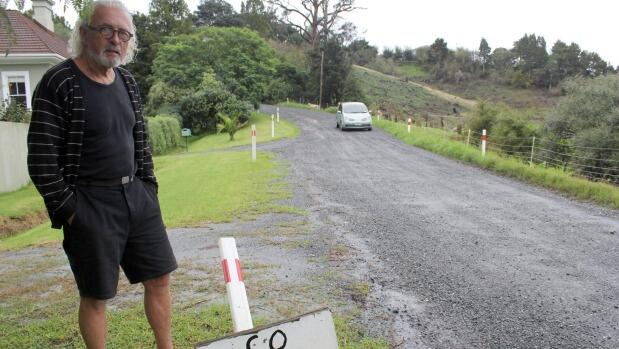Brian and Rosemary Sollis are sick and tired of the dust that infiltrates their home settling on furniture and floors.
But mostly they are sick.
The soft rasp in Rosemary’s voice, a sign of the asthma that now plagues her during summer.
Health risks from dusty unsealed roads are behind a storm brewing in Rodney
The struggle to breath as dust from hundreds of cars heading daily to the historic Wilson cement work ruins and swimming hole on the Mahurangi River, saw them pack up and leave for a month, Brian said.
When the historic Wilson home came on the market nearly four years ago, Brian leapt at the chance to own the house he’d often admired back in the 1970s.
Without Auckland Council action Brian Sollis is powerless to stop the dust that is effecting his health.
Then a derelict with no roof, the house was restored in 1980, and has been a delight to them. But, after nearly four years, the dust from the road has driven them to despair and now sees them suffering from respiratory problems. Both of their doctors attribute their ill health to the ongoing dust issue, and recommend the road be sealed.
By not sealing the road and stopping the dust Auckland Council is breaking the law, Brian maintained. Their lack of action means they are failing to protect our health, he said.
Auckland Council Rodney ward councillor Greg Sayers agrees.
Sollis says Auckland Transport has an obligation to their health to stop the dust.
“Public safety law requires Auckland Council to keep its residents safe,” he said.
Particle matter (PM) is a wide spread air pollutant and comes from many sources both natural and man-made including dust. PM of up to 10 micrometres in diameter (PM10) makes up a significant portion of road dust. Much of this dust is made of very fine particles less than PM2.5 that stay suspended in air, can get past body defences and are taken into the lungs. Here they can lead to respiratory problems.
A study of some high use unsealed roads in Northland by the New Zealand Transport Authority (NZTA) showed dust levels, particularly by heavy vehicles like logging trucks, can exceed national environmental standards for air quality at times during dry periods. The study also looked at identifying cost-effective ways to control dust related health concerns. Released in August last year Sayers, with backing from Waitemata District Health Board member Allison Roe, has taken aim at the council and Mayor Phil Goff for “ignoring” the report and not taking the health impacts of the dust seriously.
Since the report Auckland Council has joined other northern councils calling for a working party to be established including Local Government New Zealand, NZTA, some government departments and iwi to come up with an agreement on how dust is measured, what the health impacts are, and recommend mitigation strategies.
Auckland Transport is currently trialling different surfaces on Old Woodcocks Road, at Kaipara Flats, to look at reducing dust on unsealed roads.
Around 670 of Auckland’s 863 kilometres of unsealed rural roads are in the north.
Last year the local board pushed for $10 million annually for the next 10 years for sealing extensions but got just $10 million over three years under Auckland Council’s Long Term Plan. This will now reduce further from next year to $1.1million each year.
“This is blatant siphoning off rural ratepayers,” Sayers said, “a failure to keep rural residents safe and give rural ratepayers a fair return for the rates they pay.”
But concerns by Sayers and Roe over widespread health issues from the amount of dust being produced are not shared by National Institute of Water and Atmospheric Research (NIWA) air pollution expert based in Auckland, Dr Guy Coulson.
People susceptible to respiratory problems and experiencing high levels of dust may be having problems, but for most people living on rural roads, dust remains at nuisance levels, Coulson said.
Even with dust issues rural people experience less fine PM pollution and associated health risks than people in urban areas from particles released by diesel truck engines and home fires burning wood in winter, he said.
Source: http://bit.ly/2putISE














